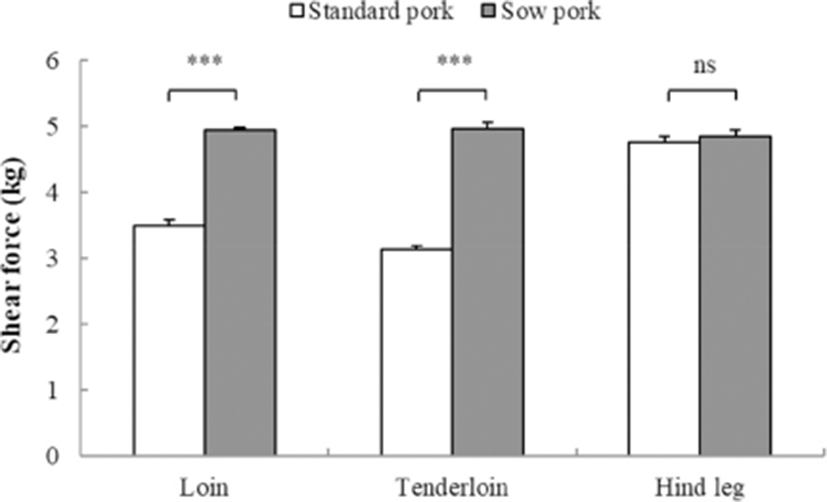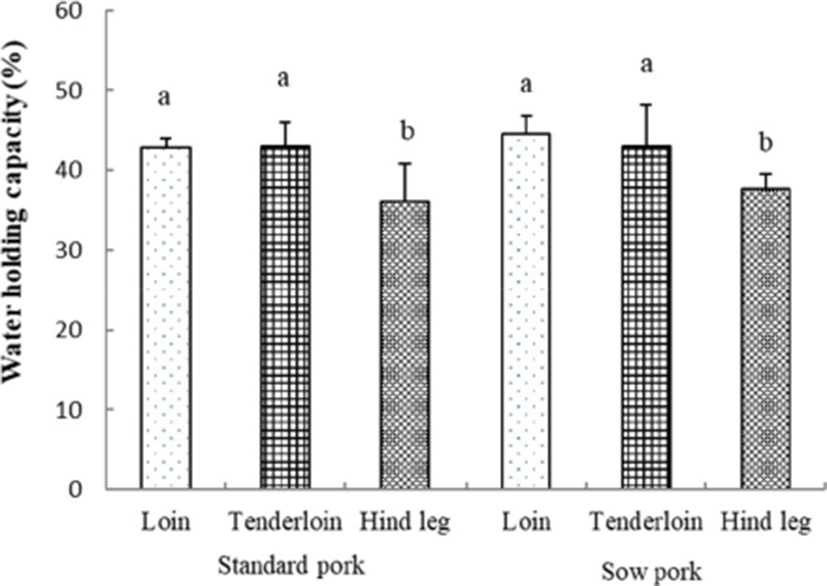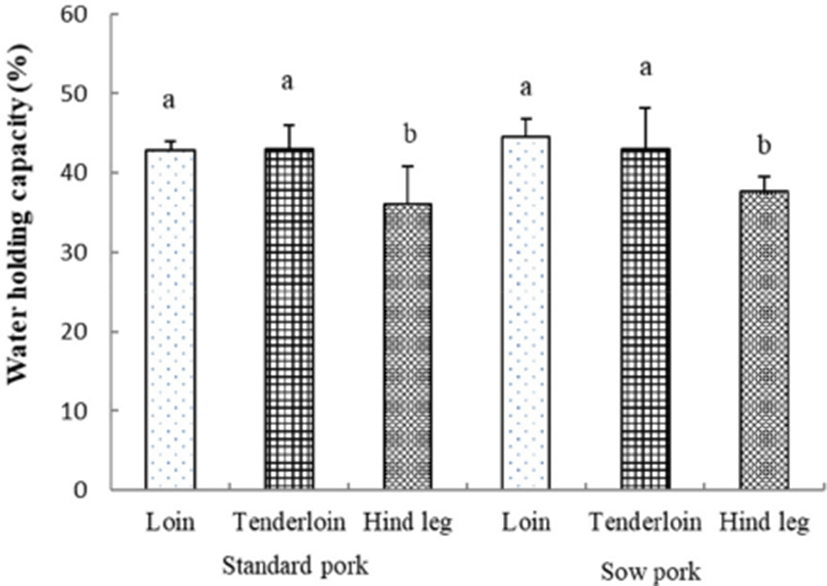Introduction
Pork is sold in seven cuts, including tenderloin, loin, Boston butt, shoulder, hind leg, belly, and ribs. While the consumption of pork belly and Boston butt has been increasing, other cuts are in less demand, thereby requiring consumption promotion plans. Also, sow pork (Landrace×Yorkshire; LY, 36 mon) is evaluated low value in market.
Consumers are evaluating sow pork as cheaper and lower in food value than standard pork (Landrace×Yorkshire×Duroc; LYD, 6 mon) despite no difference in physicochemical characteristics (Rhim et al., 1995). Studies on improving the food value of sow pork have been gaining attention. For example, one study revealed that gender and age at slaughter influence the carcass characteristics and pork quality (Choi et al., 2005), and another study reported that carcass weight and back-fat thickness are integral parts of the carcass grading system (Park et al., 2001). Other studies have reported that the color of pork is correlated with texture and water holding capacity (WHC), and that WHC can be predicted using meat color (Joo et al., 1995; Norman et al., 2003). Moreover, meat color has a significant influence on the purchasing motivation of consumers (Zhu and Brewer, 1998). It has been reported that the tenderness and quality characteristics of meat vary depending on muscle maturity, collagen content, and muscle condition (Seong et al., 2008). By comparing carcass weight, meat quality, and sensory properties between standard pork and sow pork, and by further analyzing the characteristics by cut part pork, information for consumer selection is provided.
Thus, this study aimed to compare and analyze the physicochemical and sensory characteristics, including carcass percent, yield rate by cut, proximate composition, fatty acids, color, and shear force, of sow pork and standard pork to propose a strategy that promotes the food value of sow pork.
Materials and Methods
In this study, six sow pigs (Landrace×Yorkshire; LY, 36 mon) and six standard pigs (Landrace×Yorkshire×Duroc; LYD, 6 mon) were selected from a HACCP-accredited pig farm located in the South Chungcheong region in Korea, and were slaughtered by a local processor. The lean meat was used as experimental material after storing it in a refrigerator for 24 h. The lean meat was deboned and butchered into seven cuts, including tenderloin, loin, butt, fore leg, hind leg, belly, and ribs.
Carcass, lean meat and part lean meat percentage were determined for individual samples by calculating the weight before and after cooking as follows:
The proximate composition of each sample was analyzed according to the AOAC (2012) standard. Moisture content (AOAC method 950.46B) was determined by weight loss after 12 h at 105°C in a drying oven (SW-90D, Sang Woo Scientific Co., Korea). Fat content (AOAC method 960.69) was determined by the Soxhlet method using a solvent extraction system (Soxtec® Avanti 2050 Auto System, Foss Tecator AB, Sweden), and protein content (AOAC method 981.10) was determined with an automatic Kjeldahl nitrogen analyzer (Kjeltec® 2300 Analyzer Unit, Foss Tecator AB, Sweden). Ash content was determined using a muffle furnace according to AOAC method 920.153.
Shear force was performed 10 times for each sample at room temperature using a texture analyzer (TA 1, Lloyd Co., USA) equipped with a Warner-Bratzler shear attachment. Samples (Ø25×50 mm) were collected from the central region of each meat. Prior to analysis, each sample was allowed to equilibrate to room temperature (25°C, 1 h). The shear force values were analyzed to obtain the maximum force required to shear through each sample and the results were expressed in kg.
The WHC was measured by modification of the procedure of Grau and Hamm (1953). Briefly, a 300 mg meat of each treatment was placed in a filter-press device and compressed for 3 min. The WHC was calculated from duplicate samples as a ratio of the sample film area to the total area; hence, a larger value suggests a higher WHC.
Homogenates were prepared using 4 g meat samples and 16 mL distilled water. The pH of each homogenate was measured with a pH meter (Model S220, Mettler-Toledo, Switzerland). The pH meter calibrated with pH 4.0 and 7.0 buffers in room temperature. All measurements were performed in triplicate.
The color of fresh (uncooked) and cooked meat samples were determined using a colorimeter (CR-10, Minolta, Japan; illuminate C, calibrated with a white plate, CIE L*=+97.83, CIE a*=-0.43, CIE b*=+1.98). Lightness (CIE L*), redness (CIE a*), and yellowness (CIE b*) values were recorded.
The samples heated at 80±1°C for 30 min and then core temperature of samples was reached respectively at 80±1°C. Cooking loss was determined for individual samples by calculating the weight before and after cooking as follows:
Fatty acid content was measured as described by Folch et al. (1957). First, crude fat in the sample was extracted and melted in 1 mL of chloroform, 100 μL of which was placed in a 20-mL tube. Next, we added 1 mL of methylation agent and incubated the mixture for 40 min in a water bath at 60°C. The final mixture was analyzed via gas chromatography (GC-2014, Simadzu, Japan) and the flow rate was 0.7 mL/min and the spilt ratio used was 30:1.
A trained group of ten panelists were engaged to evaluate the sensory qualities of each sample in terms of color, flavor, tenderness, juiciness, and overall acceptability. Samples were cooked to a core temperature of 75°C in a water bath (Model 10-101, Dae Han Co., Korea), cooled, cut into quarters (Ø25×20 mm), and served randomly to the panelists. Panelists were instructed to cleanse their palates between samples with water. The color (1=extremely undesirable, 10=extremely desirable), flavor (1=extremely undesirable, 10=extremely desirable), tenderness (1=extremely tough, 10=extremely tender), juiciness (1=extremely dry, 10=extremely juicy), and overall acceptability (1=extremely undesirable, 10=extremely desirable) of the cooked samples were evaluated using a ten-point descriptive scale.
The results obtained from at least three replicate experiments were selected to calculate the mean and standard deviation using SAS software (SAS, Release 8.01, SAS Institute Inc., USA). The sensory evaluation was performed using a Likert scale ranging from 1 point (poor) to 10 point (excellent), and an arithmetic average was calculated. The differences between the mean values of the experimental groups were analyzed using Duncan's multiple range tests and t-tests to determine the statistical significance at the 5%, 1%, and 0.1% levels.
Results and Discussion
Table 1 shows the carcass yield, lean meat percent, and part lean meat yield of standard and sows pork. The carcass percent of standard pork was determined as 76.39%, which tended to be higher than that of sow pork (75.53%). On the other hand, there was no significant difference in lean meat yield between the two groups. The yield rate of pork belly for standard pork was determined as 9.62%, which was significantly higher than that of sow pork (9.00%) (p<0.001), and the yield rate of spareribs for sow pork was 4.24%, which was significantly higher than that of standard pork (3.59%) (p<0.001). Furthermore, the yield rate of tenderloin for sow pork was 1.31%, which was significantly different (p<0.001) compared to that for standard pork (1.04%). However, there were no significant differences between the two experimental groups for the other four cuts.
These results were similar to those reported by Choi et al. (2005) on the yield rates of 6.39%, 10.5%, and 9.52% for loin, tenderloin, and pork belly, respectively, of marketed standard pork from slaughtered piglets. These results were also similar to those reported by Virgili et al. (2003), which showed that the yield rates of pork loin, picnic shoulder, and hind leg for pigs slaughtered at 8 mon of age were higher than those of pigs slaughtered at 10 mon of age. These results suggested that the yield rates of pigs at younger ages are high, and that the yield rate varies due to muscle development, which increases with age.
Table 2 shows the analytical results of the proximate composition of standard and sow pork. The moisture content was highest in tenderloin for standard pork (73.78%) and loin for sow pork (75.73%) (p<0.05). The crude protein content was highest in hind legs for both standard and sow pork (25.10% and 23.49%, respectively) (p<0.05). Overall, the protein content was lower in sow pork than in standard pork. The crude fat content was highest in loin for standard pork (2.91%) and hind legs for sow pork (2.34%) (p<0.05), respectively. The crude ash content was highest in hind legs for standard pork (1.12%) (p<0.05), while there was no significant difference among loin, tenderloin, and hind legs for sow pork.
These results were inconsistent with those reported by Shuler et al. (1970), who found that the fat content of pigs increased and the moisture content decreased as the actual live weight of pigs increased. On the other hand, these results were similar to those reported by Cho et al. (2012), who showed that fat content decreased as slaughter age becomes higher.
The shear forces of standard pork and sow pork are shown in Fig. 1. The average shear force of pork for three cuts was 3.85 kg and 4.92 kg in standard pork and sow pork, respectively. Loin and tenderloin showed a higher shear force in sow pork than in standard pork (p<0.05), but hind legs showed similar results in both types of pork without a significant difference. These results were similar to those reported by Xiong et al. (2007) and Cho et al. (2012), who reported that shear force increased as age increased, and were inconsistent with the results reported by Moon et al. (2003), who indicated that there was no significant difference in slaughter weight, which could be explained by the fact that the study was conducted to determine the slaughter weight of standard pork rather than old-aged sow pork.

The WHC of each type of pork by cut is shown in Fig. 2. The average WHC of standard pork and sow pork was 40.67% and 41.75%, respectively, thereby showing a similar tendency. The WHC of tenderloin and loin for standard pork and sow pork was not significantly different, with both showing the lowest WHC in hind legs (p<0.05). WHC has been reported to be related to the maximum pH, protein denaturation, and sarcomere length (Warner et al., 1997), which suggests that the WHC influences water retention capacity in muscle, meat color, fresh meat quality, and texture, thereby making it an important meat quality factor in manufacturing of meat products.

Table 3 shows the pH and meat color of standard pork and sow pork by before and after cooking.
Before cooking, the pH values of tenderloin and hind legs for standard pork and sow pork were 5.65 and 6.34, respectively, which were significantly highest (p<0.05). The CIE L* (lightness) values of loin were 56.67 and 46.10 in standard pork and sow pork, respectively, which were significantly high (p<0.05). The CIE a* (redness) values of tenderloin were 12.62 and 12.94 in standard pork and sow pork, respectively, which were the highest (p<0.05). The CIE b* (yellowness) values of loin were 6.07 and 4.14 in standard pork and sow pork, respectively, which were the highest (p<0.05). These values were lower in sow pork than in standard pork. The pH values were typically higher after cooking than before cooking, and were higher in sow pork than in standard pork (p<0.05).
After cooking, the pH values of tenderloin and hind legs for standard pork and sow pork were 5.91 and 6.46, respectively (p<0.05). The CIE L* values of loin were 71.41 and 65.57, which were the highest (p<0.05) in both standard pork and sow pork, respectively. The CIE a* values were the highest at 8.16 for tenderloin of standard pork and 7.91 for the hind legs of sow pork (p<0.05). The CIE b* value of tenderloin for standard pork was the highest at 13.09, while the CIE b* value of tenderloin for sow pork was the lowest at 9.37 (p<0.05).
These results were somewhat different to those reported by Moon et al. (2003), who stated that the intramuscular pH tended to decrease as slaughter age increased, and were consistent with the results reported by Park et al. (2001), who reported that the pH tended to increase as the CIE L* values decreased. The results of increased pH after cooking (Morin et al., 2002) and the pH of 5.24 for standard pork (Choi et al., 2005) were consistent with the results of this study.
The results of cooking loss are shown in Fig. 3. Cooking loss showed a significant difference (p<0.05) between standard pork and sow pork. The cooking losses of tenderloin and hind leg in standard pork and sow pork were similar, but were significant that of loins (p<0.05). The cooking losses of loin in standard pork and sow pork were 33.12% and 30.04%, respectively. In this case, the cooking loss in standard pork was significantly higher (p<0.05).

These results were consistent with those reported by Čandek-Potokar et al. (1998), who reported that the cooking loss decreased as the pig age increased, as well as with those reported by Moon et al. (2003), who stated that the cooking loss decreased as carcass weight increased. Furthermore, these results were consistent with those reported by Virgili et al. (2003), who showed that the drip loss and cooking loss rate decreased as carcass age increased. These results suggested that sow pork can be used to produce economically superior meat products.
Table 4 shows fatty acid composition of standard pork and sow pork. There was no significant difference in the fatty acid composition for the two groups of pork for lower fatty acids and saturated fatty acids. Despite no significant difference in unsaturated fatty acids, the fatty acid composition for unsaturated fatty acids tended to be relatively higher in sow pork (62.14%) than in standard pork (61.82%).
However, the fatty acid composition of arachidonic acid, which is a higher fatty acid, was 0.38% and 0.84% in standard pork and sow pork, respectively. In this case, the fatty acid composition was significantly higher in sow pork (p<0.05). These results were similar to those reported by Virgili et al. (2003), who reported no significant difference between the age groups. Furthermore, these results were similar to those reported by Cho et al. (2012), who reported that the content of total saturated fatty acids increased as carcass age increased, and that the content of polyunsaturated fatty acids increased as carcass age decreased. Some studies reported that numerous fatty acids showed significant differences when comparing those from improved varieties and native varieties (In, 2013). These differences could be attributed to the varieties.
Table 5 shows the sensory evaluation results of standard pork and sow pork meat. The highest color value was observed in hind leg of sow and standard pork, while the lowest color value was found in loin of sow pork (p<0.05). Warner et al. (1993) reported that meat color was the most important factor among many quality factors. The flavor values of three cuts showed no significant difference between standard pork and sow pork, which were similar in the range of 8.7 to 8.2. However, the flavor values tended to be lower in sow pork. The tenderness of tenderloin was 8.5 point in sow pork, which was higher than that of standard pork with 7.9 point. On the other hand, the tenderness of hind leg in sow pork was 7.4 point, which was evaluated as lower than that of standard pork with 8.5 point (p<0.05). The juiciness and off-flavor showed no significant differences between the two groups. The overall acceptability of loin and hind leg was 8.5 and 8.7, respectively, in standard pork, and the overall acceptability of both cuts was 8.3 in sow pork, which showed high acceptability (p<0.05). Based on the results of the sensory evaluation, it would be possible to develop various meat products using tenderloin and hind leg of cheap sow pork. These results were consistent with those reported by Čandek-Potokar et al. (1999), who reported that weight gain resulted in a decrease in grading points of tenderness and chewiness, as well as with those reported by Jin et al. (2004), who reported that weight gain resulted in a decrease in hardness.
Conclusion
The present study compared and analyzed the physicochemical properties of carcasses, including yield, fatty acids, WHC, shear force, meat color, cooking loss, and sensory evaluation, for six standard pigs and six sow pigs. Through the analysis, this study aimed to obtain basic data to improve the food value of sow pork as well as to develop appropriate raw sources for meat products. The part lean meat yield of pork belly was significantly higher in standard pork than in sow pork (p<0.001), while the value of spareribs and tenderloin was significantly higher in sow pork than in standard pork (p<0.001). The moisture content of standard pork and sow pork was 73.78% and 75.73%, respectively, which showed the highest content (p<0.05). The crude protein content of hind legs was the highest in standard pork than sow pork (p<0.05). The crude fat content of loin in standard and sow pork was the highest (p<0.05). The shear force of sow pork was significantly higher than that of standard pork (p<0.05). The WHC of standard pork and sow pork by cut showed a significant difference (p<0.05), and the WHC was the lowest in hind legs. The pH, CIE L* value, CIE a* value, and CIE b* value after cooking showed higher values in sow pork than in standard pork. The values of arachidonic acid and unsaturated fatty acids were lower in standard pork than in sow pork (p<0.05). However, the values of total unsaturated fatty acids showed a higher trend in standard pork than in sow pork, despite no significance. These results suggested that tenderloin and hind leg of cheap, aged sow pork can be developed as various meats.













